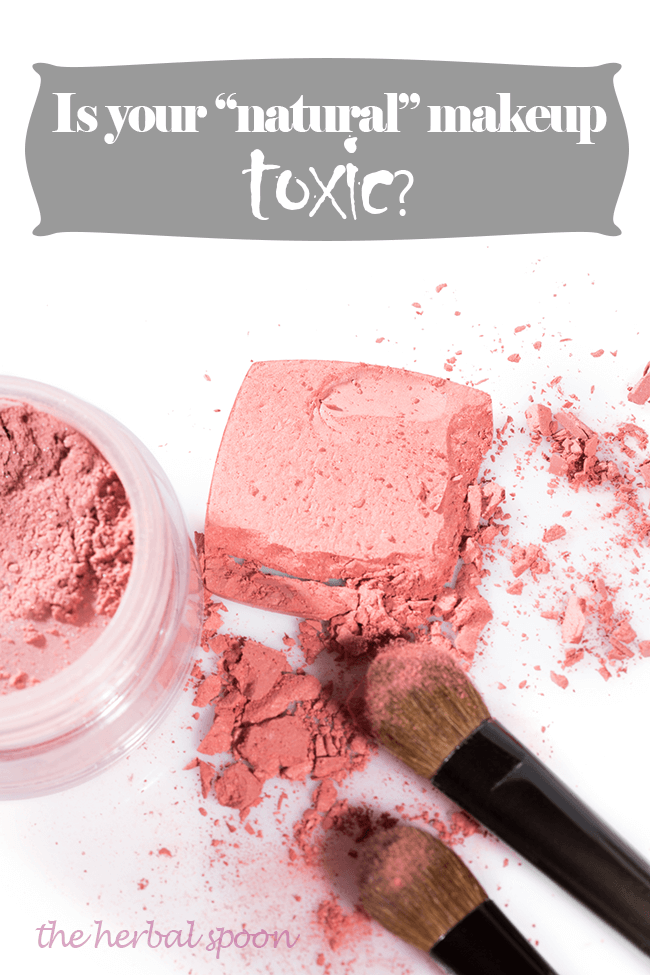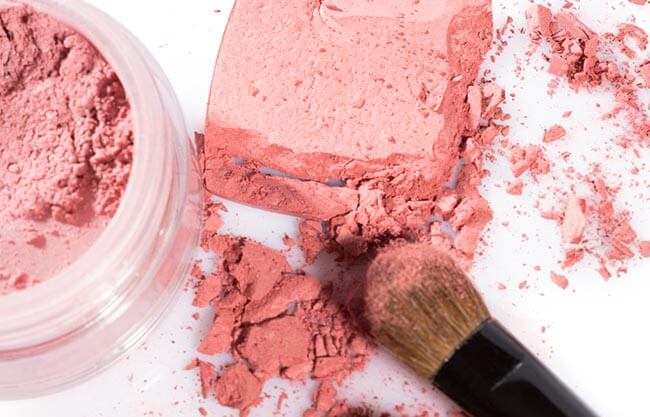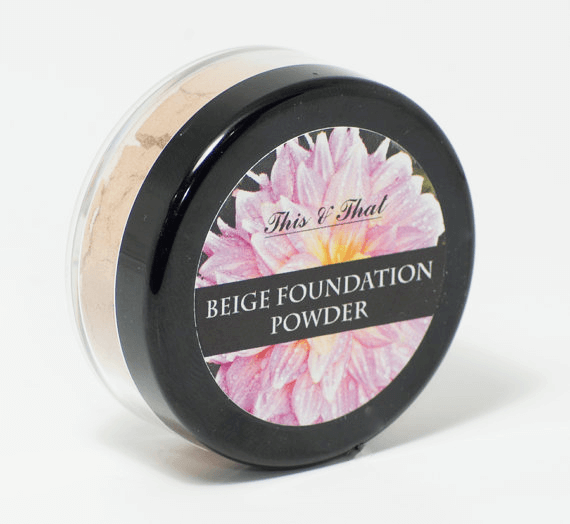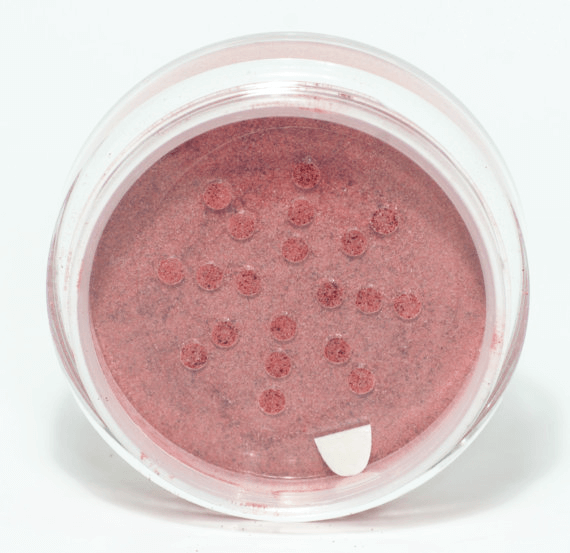
It seems like everyone is jumping on the natural bandwagon lately and makeup is no exception.
How can you cut past the hype though and find products that are truly natural and non-toxic? How do you know if your so called natural makeup is actually toxic?
My History with Makeup
In high school I had fun shopping the makeup aisle, trying different lip gloss colors and using heavy concealer for those teenage blemishes. My biggest concern with buying makeup was if I should get the volumizing or lengthening mascara. I never thought twice about the ingredients label, in fact, I don’t think I ever once looked at the ingredients.
In college I started wearing makeup less often to cut down on the toxins going into my body. I still held onto that jar of heavy foundation though for the occasional pimple. The past few years I’ve ditched conventional makeup altogether. Yes, even that last jar of foundation finally made its way to the trashcan last month.
How Natural Makeup Brands Stack Up
If you’re like me and trying to go the natural route when it comes to makeup, you may be surprised to see then that some of the “natural” options really aren’t so natural. Some of them have some truly nasty ingredients. Below I’ve delved into the ingredients of some popular natural brands to see how they stack up.
Tarte
This brand is sold at retailers like Sephora and boasts ingredients like chamomile, ginseng and green tea. However, there are some unsavory ingredients mixed in with the natural ones, making this brand not my top choice. Some of their products are fairly clean, even though they still contain heavy metals from certain minerals, while others are loaded with synthetic and toxic ingredients.
Amazonian clay BB illuminating moisturizer
- Retinyl Palmitate -Biochemical or cellular level changes, Cancer, Developmental/reproductive toxicity, Organ system toxicity
- Oxybenzone– Enhanced skin absorption, Biochemical or cellular level changes, Developmental/reproductive toxicity, Endocrine disruption, Allergies/immunotoxicity, Organ system toxicity (non-reproductive), Persistence and bioaccumulation
- Octinoxate– Enhanced skin absorption, Biochemical or cellular level changes, Developmental/reproductive toxicity, Endocrine disruption, Allergies/immunotoxicity, Organ system toxicity (non-reproductive), Persistence and bioaccumulation
- Phenoxyethanol– Allergies/immunotoxicity, Irritation (skin, eyes, or lungs), Organ system toxicity (non-reproductive), Occupational hazards, Use restrictions
Vitamin infused lip gloss
- Fragrance– (which can be a chemical cocktail of anything) Ecotoxicology, Allergies/immunotoxicity, Irritation (skin, eyes, or lungs), Miscellaneous, Organ system toxicity (non-reproductive
- Retinyl acetate – Biochemical or cellular level changes, Cancer, Developmental/reproductive toxicity, Organ system toxicity (non-reproductive), Use restrictions
- Heavy metals like tin and aluminum
- Artificial colors made with aluminum
Bare Minerals
This brand is heavily marketed on tv and in stores as being natural, but it has some ingredients I’d prefer to stay away from.
- Retinyl palmitate – Biochemical or cellular level changes, cancer
- Eugenol – Allergies/immunotoxicity, Organ system toxicity (non-reproductive), Use restrictions
- Benzyl benzoate – Ecotoxicology, Endocrine disruption, Allergies/immunotoxicity, Occupational hazards, Use restrictions
- Artificial colors – cancer, organ system toxicity, persistence and bioaccumulation
- Aluminum powder – neurotoxin, Enhanced skin absorption, Organ system toxicity (non-reproductive),
Cowgirl Dirt
This brand was recently bought out and loyal customers are upset with some of the changes. More natural ingredients have supposedly been replaced by questionable ones.
- Retinyl palmitate – Biochemical or cellular level changes, Cancer, Developmental/reproductive toxicity, Organ system toxicity (non-reproductive), Use restrictions
- Octinoxate – Enhanced skin absorption, Biochemical or cellular level changes, Developmental/reproductive toxicity, Endocrine disruption, Allergies/immunotoxicity, Organ system toxicity (non-reproductive), Persistence and bioaccumulation
- Polysorbate-60 – Biochemical or cellular level changes, Cancer, Developmental/reproductive toxicity, Organ system toxicity (non-reproductive), Use restrictions
- Phenoxyethanol -Allergies/immunotoxicity, Irritation (skin, eyes, or lungs), Organ system toxicity (non-reproductive), Occupational hazards, Use restrictions
- Ethanol – Enhanced skin absorption, Multiple, additive exposure sources, Organ system toxicity (non-reproductive)
- Sodium laureth sulfate – Contamination concerns (ETHYLENE OXIDE, 1,4-DIOXANE, ETHYLENE OXIDE, 1,4-DIOXANE), Organ system toxicity (non-reproductive), Use restrictions
- Diazolidinyl Urea – formaldehyde releaser that can cause cancer

Aveda
This brand used to be like the slick gunslinger in a western. You didn’t know what side they’re really on until you see what they’re made of. The brand has since made their ingredients available on their website, but I can’t say I’m too impressed. There are some great natural plant extracts and oils, but plenty of toxic or unknown ingredients.
- Fragrance – (which can be a chemical cocktail of anything) Ecotoxicology, Allergies/immunotoxicity, Irritation (skin, eyes, or lungs), Miscellaneous, Organ system toxicity (non-reproductive
-
PENTAERYTHRITYL TETRAISOSTEARATE – That’s quite a mouthful. This ingredient doesn’t have any data behind it so we don’t have any idea if it’s safe. It could be a safe synthetic chemical concoction… or not.
- Methylisothiazolinone – Ecotoxicology, Allergies/immunotoxicity, Irritation (skin, eyes, or lungs), Neurotoxicity, Use restrictions
- Methylchloroisothiazolinone – Cancer, Ecotoxicology, Allergies/immunotoxicity, Irritation (skin, eyes, or lungs), Use restrictions
- Artificial colors – Red 6, Yellow 6, Blue 1, etc. etc. There’s very limited safety data and scientists don’t have enough info to say if it doesn’t cause cancer or other health effects.
EWG report (source) (source)
Younique
Like the others this brand features some nourishing natural ingredients mixed in with some toxic ones. Here I’ve highlighted the Beach Front Bronzer and a mascara. Some of their products are pretty clean, but you have to be careful what you get and really analyze each product’s ingredients.
- Octinoxate– Enhanced skin absorption, Biochemical or cellular level changes, Developmental/reproductive toxicity, Endocrine disruption, Allergies/immunotoxicity, Organ system toxicity (non-reproductive), Persistence and bioaccumulation
- Corn starch – probably gmo and contaminated with toxic pesticides
- Talc – has been linked to cancer and the focus of many lawsuits right now
- Phenoxyethanol – Allergies/immunotoxicity, Irritation (skin, eyes, or lungs), Organ system toxicity (non-reproductive), Occupational hazards, Use restrictions
- Vinyl dimethicone – “Flexible silicon polymers consisting of dimethicone copolymers that are linked together.” (source) It’s been deemed safe by EWG, but still not something I’d love to have on my face.- See more at:
- Phenoxyethanol – Allergies/immunotoxicity, Irritation (skin, eyes, or lungs), Organ system toxicity (non-reproductive), Occupational hazards, Use restrictions
Physician’s formula
- Aluminum powder – heavy metals like aluminum have been linked to neurotoxicity and diseases like Alzheimers. (source, source)
- Retinyl acetate – Biochemical or cellular level changes, Cancer, Developmental/reproductive toxicity, Organ system toxicity (non-reproductive), Use restrictions
- Fragrance – A chemical cocktail of practically anything, typically neurotoxic
- Boric acid – Developmental/reproductive toxicity, Endocrine disruption, Multiple, additive exposure sources, Organ system toxicity (non-reproductive), Use restrictions
- Quaternium 15 (formaldehyde releaser) – Cancer, Allergies/immunotoxicity, Contamination concerns, Irritation (skin, eyes, or lungs), Organ system toxicity (non-reproductive), Use restrictions
- Parabens – Biochemical or cellular level changes, Data gaps, Developmental/reproductive toxicity, Endocrine disruption, Allergies/immunotoxicity, Use restrictions
Bite Beauty
- Hydrogenated vegetable oil – highly processed and closer to plastic than oil (source)
- Hydrogenated castor oil – ditto to above
- Polypropanediol dimer dilinoleate – a synthetic chemical derived from gmo corn and soy products. Likely contaminated with round up and other chemicals sprayed on the corn and soy. (source) (source)
The bottom line with natural makeup
There are a lot of cosmetic ingredients that just don’t have enough (or any) safety data on them. Until I can know for sure that a synthetic chemical is safe, it’s staying off my face. Just because a brand pledges to stay away from a list of potential toxins, doesn’t mean they aren’t using other ones. On the other hand, some ingredients, like alpha tocopherol, may sound scary, but it’s really just vitamin E.
Best practice is to always read the back of the label and research the safety of the ingredients.
Truly healthy makeup
I like to be an informed consumer, but I also don’t like having to decipher and analyze every single ingredient label from the brand I’m using. To save myself time and to ensure I’m doing what’s best for my skin and my health, I like using clean makeup without all the nasties. I don’t want to end up with Alzheimer’s or cancer just from using some foundation powder!
Here you can find a collection of completely safe and non-toxic makeup recipes if you’re the diy type. If you don’t want to spend the time or don’t have the ingredients you need on hand, then there are other, healthy options you can buy. In fact, the makeup I’ve created for my body care shop, This & That Herbal is plant based, non-toxic and free of heavy metals. Unlike the other brands that advertise herbs and oils, I don’t include all the nasty stuff along with them.

You can read more about the plant based foundation powder here.

Read more about my plant based blush here. (this can also be used as eyeshadow!)
Interesting post! Thanks for linking up to Merry Monday! Sharing on G+! Have a great week!
Kim
This is a great resource. thanks so much for sharing!
That’s so crazy how much is marketed as “natural” when it truly isn’t safe. So much is allowed under that label, which is truly unfortunate. I’m glad there are some safe options available though.
Thank you so much for clearing up all of those ingredients! I didn’t know some of those!
Haha! Love your metaphor about Aveda! 😉 I used to buy their stuff. Thanks, this is really helpful.
haha yes… one of the clients I stay with watches westerns for hours on end so they must have made an impression 😉
So sad that cosmetic companies can’t just make NATURAL makeup. Why on earth do they need those awful ingredients? Makes zero sense!
I know that they’re trying to cheaply make products that perform well, and many are just buying into the hype of the term “natural”. It’s sad the lack of integrity I’m seeing from so many though.
yes ‘natural’ is a very deceptive term!
So glad you told people about what is in so called natural products. Your foundation sounds divine!
This is such valuable and enlightening information! I use a lot of different so-called natural and organic products so this is quite disturbing. Thank you for sharing Is Your Natural Makeup Actually Toxic at the Healthy, Happy, Green and Natural Party Blog Hop. I’m Pinning and sharing!
Lead is proven to be the most toxic ingredients to be used in makeup products. It is generally linked to reduced fertility and the onset of puberty for females. This can cause harm to the skin, for those who wear it regularly.
What about “Pacifica” make up? I want to get actual natural make up..seems like companies are tricking??
I’m not familiar with pacifica makeup, but the EWG skindeep database has a summary of the ingredients in some of their products and how they’re rated here. http://www.ewg.org/skindeep/company/Pacifica%2C_Inc./ They have a lot of good in them, however they also use a lot of synthetic ingredients that have little to no research available into their safety, which is something I’m not so comfortable with personally.
Have you tried Young Living’s Savvy Minerals makeup? It’s the cleanest makeup out there now!
I have not. I’m very uncomfortable with Young Living’s business practices and don’t feel good about supporting them. And personally I prefer to use plant based and not mineral makeup , no matter how clean it claims to be.
Young Living Savvy Minerals makeup is awesome. The EU bans over 1600 chemicals from makeup. Young Living has 2500 chemicals they will not use. No Parabens, no talc, no heavy metals, no SLS, no phthalates, mainly vegan except for lip balm, and cruelty free. I feel absolutely confident using and promoting Savvy Minerals from Young Living.
The young living website is down at the moment and I can’t find the ingredients lists anywhere to see exactly what they use, but that’s awesome if they are truly a clean product. My main concern is the ethics of this company and their history with being dishonest and then covering it up. I was very interested in using them awhile ago because I liked the looks of what they’re trying to do, however when I dug into the evidence the appearance didn’t match up with their practices. I can’t in good conscience support and recommend a company that does that.
Please look into Limelight by Alcone. Amazing products! Not all are natural but they are working on. The skin care line is completely vegan, paraben free, phthalate free, dye free, SLS free and leaping bunny certified. A lot of the makeup is the same way and soon it will all be that way ☺
It seems like they have a long way to go before they could be considered a safe makeup brand. Their Botanical Foundation alone has artificial dyes, heavy metals and endocrine disruptors! “IPM, Castor Oil. Carnauba, Candililla, Ozokerite, Titanium Dioxide, Iron Oxides, Propyl Paraben, BHT. Also May Contain: D&C Red #6, D&C Red #7, D&C Red #27, Cos. Green, Cos. Blue.” Hopefully they keep cleaning things up.
How about BeautyCounter?
I know some people love it, but I haven’t really delved into their ingredients. You could always check their ingredients out on the environmental working group’s Skin Deep database. Some brands advertise as being all natural mineral makeups, but I prefer to stick to plant based and avoid minerals and heavy metals entirely.
Avada has been paraben free for YEARS! Need to update this.
I went through their website again and saw that they’ve updated some things. I made sure to edit that in the article. Thanks for your comment!
Interesting post. Thank you